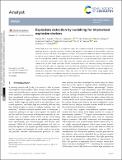Explosives detection by swabbing for improvised explosive devices
Abstract
Swabs taken from the surface of a suspicious object are a standard method of identifying a concealed explosive device in security-conscious locations like airports. In this paper we demonstrate a sensitive method to collect and detect trace explosive residues from improvised explosive devices using swabs and an optical sensor element. Swabs coated with a commercial fluoropolymer are used to collect material and are subsequently heated to thermally desorb the explosives, causing the quenching of light emission from a thin film luminescent sensor. We report the sorption and desorption characteristics of swabs loaded with 2,4-DNT tested with Super Yellow fluorescence sensors in a laboratory setting, with detection that is up to three orders of magnitude more sensitive than standard colorimetric tests. The method was then applied in field tests with raw military-grade explosives TNT, PETN and RDX, on various objects containing the explosives, and post-blast craters. We show for the first time results using organic semiconductors to detect sub-milligram amounts of explosive sorbed onto a substrate from real explosives in the field, giving a promising new approach for IED detection.
Citation
Glackin , J M E , Gillanders , R N , Eriksson , F , Fjällgren , M , Engblom , J , Mohammed , S , Samuel , I D W & Turnbull , G 2020 , ' Explosives detection by swabbing for improvised explosive devices ' , Analyst . https://doi.org/10.1039/D0AN01312A
Publication
Analyst
Status
Peer reviewed
ISSN
0003-2654Type
Journal article
Description
Funding: The authors acknowledge funding from the EPSRC DTG (EP/L505079/1) and EPSRC (EP/N509759/1).Collections
Items in the St Andrews Research Repository are protected by copyright, with all rights reserved, unless otherwise indicated.

